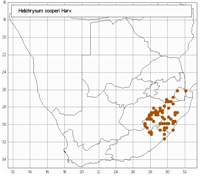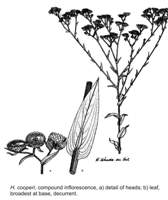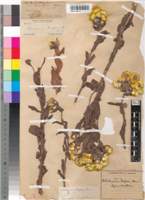Common names:
Yellow everlasting, Geel sewejaartjie (A), Bohloko (SS), umadotsheni (Z)
Origin of name:
cooperi is named after Thomas Cooper (1815�1913) of Reigate, who collected many interesting plants in the Eastern Cape and KwaZulu-Natal between 1859 and 1862.
Diagnostic characters:
Large solitary headsOpen branched inflorescencesYellow bractsWoolly leaf marginsDecurrent leaves
Description:
Biennial or perennial herb up to 1.5 m tall, aromatic, stem stout, base up to 10 mm diam., simple below the inflorescence, glandular-setose, inflorescence branches sometimes thinly white-cobwebby as well, leafy. Radical leaves usually wanting at flowering, but rosetted in first year of growth, up to c. 150 (�250) x 60 mm, elliptic, tapering to a broad clasping base, glandular or very thinly woolly; cauline leaves mostly 65�130 x (15�) 20�45 mm, smaller upwards, oblong-lanceolate to lanceolate, apex acute or sometimes acuminate on uppermost leaves, apiculate, base cordate-clasping, the main stem leaves in particular usually decurrent in long or short wings, both surfaces glandular-setose, margins often white-woolly as well, very rarely some leaves thinly woolly below. Heads heterogamous, depressed-globose, c. (8�) 10�12 mm long, c. 15�25 mm across the radiating bracts, many in a large spreading leafy corymbose panicle. Involucral bracts in c. 9 series, slightly graded, imbricate, much exceeding the flowers, glossy bright yellow, backs of outer rarely overlaid palest brown. Receptacle shortly honeycombed. Flowers c. 650�1200, 50�160 female, 600�1100 homogamous. Achenes 1 mm long, barrel-shaped, glabrous. Pappus bristles many, equaling corolla, tips barbellate, bases with patent cilia, lightly cohering or not.
Flowers between December and April.
Distribution:
Grows in grassland, often in the coarse herbage on or near forest margins, or, in the Drakensberg in particular, along drainage lines or in scrub among boulders and on scree. Recorded with certainty from the low Drakensberg on the Mpumalanga-KwaZulu-Natal border thence south through the mountainous parts of the Free State, Lesotho, and the Midlands and Uplands of KwaZulu-Natal to the Transkei and the Eastern Cape, between Maclear and Naude's Nek.
Grassland and Savanna Biomes.
Notes:
The name H. cooperi is frequently misapplied to plants in Mpumalanga, Limpopo and tropical Africa. It is not clear, however, if H. cooperi occurs further north than the low Drakensberg on the Mpumalanga-KwaZulu-Natal border. It is characterized by its biennial habit, green leaves shortly to strongly decurrent on the stem, heads in a spreading corymbose panicle, and involucral bracts usually bright yellow inside and out.
Taxonomy:
Literature:
Helichrysum cooperi Harv. in F.C. 3: 231 (1865); Moeser in Bot. Jb. 44: 338 (1910); Hilliard, Compositae in Natal 243 (1977).
Type:
Free State, near Drakensberg, Cooper 1117 (TCD, holo.; BM; E; K; PRE; W; Z, iso.).
Synonym(s):
Vouchers:
Devenish 571 (PRE); Hilliard & Burtt 10093 (E; K; MO; NU; S); Tyson 1640 (SAM); Wright 481 (E; K; MO; NU; S).



